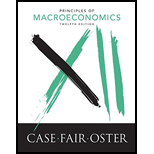
Principles of Macroeconomics Plus MyLab Economics with Pearson eText (1-semester access) -- Access Card Package (12th Edition)
12th Edition
ISBN: 9780134424026
Author: Karl E. Case, Ray C. Fair, Sharon E. Oster
Publisher: PEARSON
expand_more
expand_more
format_list_bulleted
Question
Chapter 15, Problem 1.3P
Sub part (a):
To determine
Average propensity to consume.
Sub part (b):
To determine
Changes in consumption as income rises.
Sub part (c):
To determine
Relationship between APC and MPC
Sub part (d):
To determine
Relationship between APC and MPC
Expert Solution & Answer
Want to see the full answer?
Check out a sample textbook solution
Students have asked these similar questions
Use both numerical and graphical methods to find the multiplier effect of the following shift in the consumption function in an economy in which investment is always $220, government purchases are always $100, and net exports are always 2-40. (Hint: What is the marginal propensity to consume?)
Consider the hypothetical country of Kejimkujik. Suppose that national income in Kejimkujik is $300 billion, households pay $100 billion in taxes, household consumption is equal to $160 billion, and the marginal propensity to consume (MPC) is 0.6.
On the following graph, use the blue line (circle symbol) to plot the economy's consumption function.
Consumption Function050100150200250300350400450500500450400350300250200150100500CONSUMPTION (Billions of dollars)DISPOSABLE INCOME (Billions of dollars)
Suppose now that Kejimkujik’s national income increases to $330 billion. Assuming the amount paid in taxes is fixed at $100 billion and that MPC = 0.6, what is the new amount of household consumption?
$148 billion
$219.4 billion
$220.6 billion
$178 billion
Consider an economy described by the following equations:
Y = C+I+G
C = 100+0.75 (Y-T)
I = 500-50r
G = 125
T = 100
where Y is GDP, C is consumption, I is investment, G is government purchases, T is taxes, and r is the interest rate. If the economy were at full employment (that is, at its natural rate), GDP would be 2,000.
Explain the meaning of each of these equations.
What is the marginal propensity to consume in this economy?
Suppose the central bank’s policy is to adjust the money supply to maintain the interest rate at 4 percent, so r = 4. Solve for GDP. How does it compare to the full-employment level?
Assuming no change in monetary policy, what change in government purchases would restore full employment?
Assuming no change in fiscal policy, what change in the interest rate would restore full employment?
Chapter 15 Solutions
Principles of Macroeconomics Plus MyLab Economics with Pearson eText (1-semester access) -- Access Card Package (12th Edition)
Knowledge Booster
Similar questions
- Which of the following statements about consumption is correct? (1) The level of autonomous consumption determines the position of theconsumption function;(2) The marginal propensity to consume determines the position of theconsumption function;(3) The level of autonomous consumption determines the slope of theconsumption function;(4) The level of income determines the slope of the consumption function.arrow_forwardIn an economy, autonomous consumption expenditure is $50 billion, investment is $200 billion, and government expenditure is $250 billion. The marginal propensity to consume is 0.7 and net taxes are $250 billion. Exports are $500 billion and imports are $450 billion. Assume that net taxes and imports are autonomous and the price level is fixed. What is the consumption function? What is the equation of the AE curve? Calculate equilibrium expenditure. Calculate the multiplier. If investment decreases to $150 billion, what is the change in equilibrium expenditure? Describe the process in part (e) that moves the economy to its new equilibrium expenditure.arrow_forwardIf combine the accounting definition E= C+I and the consumption function C=co + cY to give an equation in which expenditure is a function of output, E = f (Y), and we plot this function on axes with income on the horizontal axis and expenditure on the vertical axis, a reduction in the marginal propensity to consume will lead to: a. a shift downwards in the line with unchanged slope b. a less steep line c. a shift upwards in the line with unchanged slope d. a steeper linearrow_forward
arrow_back_ios
arrow_forward_ios
Recommended textbooks for you



 Economics (MindTap Course List)EconomicsISBN:9781337617383Author:Roger A. ArnoldPublisher:Cengage Learning
Economics (MindTap Course List)EconomicsISBN:9781337617383Author:Roger A. ArnoldPublisher:Cengage Learning





Economics (MindTap Course List)
Economics
ISBN:9781337617383
Author:Roger A. Arnold
Publisher:Cengage Learning

